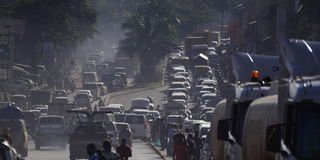Prime
Kampalans lose 52 days to traffic jam every year

Traffic jam on Jinja Road in Kampala. An individual in Uganda loses at least 52 working days every year due to traffic congestion. PHOTO | ABUBAKER LUBOWA
What you need to know:
- Several studies have linked the time wasted in transit to a decline in productivity, air pollution and chaos on roads. The increasing amount of time spent in traffic also reduces time spent with family members and on other tasks given that the traffic congestion is often two-way.
An individual in Uganda loses at least 52 working days every year due to traffic congestion. The estimate is contained in a parliamentary report based on a five-day workweek.
To break it down, Ugandans spend 90 minutes a day in gridlock, which translates to 450 minutes or 7.5 hours a workweek. This is equivalent to losing one working day to traffic jams each week.
Losing this much working hours daily is costing the economy in Kampala hundreds of millions of dollars annually, the parliamentary Committee on the National Economy has noted.
A 2020 research paper dubbed “The cost of congestion in Kampala, Uganda” by the International Growth Centre (IGC) shows around Shs5.7 billion or $1.5m—equivalent to 4.2 percent of the Greater Kampala area’s daily GDP—is lost to traffic congestion.
Several studies have linked the time wasted in transit to a decline in productivity, air pollution and chaos on roads. The increasing amount of time spent in traffic also reduces time spent with family members and on other tasks given that the traffic congestion is often two-way.
Gridlock costs are also cited together with the high cost of electricity, high interest rates, and regressive tax regimes as factors that impede private sector competitiveness in the country.
“Consequently, the high cost of doing business affects growth of the firms and job creation as well as economic growth in the country,” the Committee on the National Economy’s report reads in part.
Peak hours
Traffic jam is at its highest during peak hours on the commute to (between 6am and 10am) and from (between 5pm and 8pm) work. It could get worse or better depending on the weather, with episodes of rain exacerbating the congestion.
In Uganda, the parliamentary committee observes, the cost of transport accounts for more than 40 percent of the total production and distribution costs; as opposed to a maximum of 10 percent in best practices.
“The cost of distribution in urban centres alone is 10 percent of total price, above the four percent according to best practice, while that of distribution for agricultural products being sold as inputs into agro-processing range from 15 to 25 percent of the total price of the product depending on the distance, above the 7.5 percent recommended in best practices. The situation has worsened with the current fuel prices,” the committee report states.
“In addition, poor road network affects the time one needs to reach a certain destination. Poor road network further results into persistent mechanical breakdowns of vehicles, thus increasing the cost of doing business,” the report adds.
Not good enough
The committee observed that the current allocation for road maintenance is very low with some districts receiving as little as Shs25m a quarter from the Uganda Road Fund, which is inadequate for maintenance of roads that are cut off by the heavy rains. This ultimately affects movement of persons and goods across affected areas.
“Kampala’s current transport system is not working to the benefit of its users, its operators or the government. It is not a transportation system that is providing a mobility service. Nor is it able to unlock the connectivity and thus productivity benefits of urbanisation,” Ms Astrid Rosemary Ndagano Haas, an Austrian-Ugandan urban economist in The Conversation, writes.
She proposes that Kampala urgently considers how to introduce a viable mass public transportation system which includes considering both how to reduce the impact on climate as well as the system’s resilience to acute shocks and chronic stresses of climate-induced changes.
Junior Kampala minister Kyofatogabye Kabuye conceded to Parliament in October last year that congestion in the city has a bearing on the cost of doing business. He admitted that it causes financial loss to travellers who use public transport. This includes the effect the traffic jam has on the fluctuation in public transport fares.
“The most affected persons are the low-income earners, making up more than 40 percent of greater Kampala Metropolitan area’s population, who spend more than 20 percent of their gross income on transport,” Mr Kabuye is quoted in a Parliament statement.
Slow progress
While improving the road and railway infrastructure have been touted by the authorities to fix the chronic traffic jam among other issues, progress on both has been very slow.
In Mr Kabuye’s address last October, he informed the House of the government’s plan to address congestion in the city with the design and construction of 31.4km of roads and installation of traffic signals at 22 junctions.
Further, he said that KCCA—in conjunction with Uganda Railways Corporation—was working on renovation of passenger services between Kampala and Namanve, covering Namboole, Kireka and Nakawa stopovers. Evidence on ground shows little to no progress has been made in this regard.
Kampala City has a road network of about 2,110km. Of these, about 646km are tarmacked roads, according to KCCA’s data.
Most of the projects under the planned $909m (about Shs3.4 trillion) road infrastructure initiative in Kampala City and surrounding areas are yet to take off. In some cases, threats to withdraw donor funds have been made due to delayed implementation.




